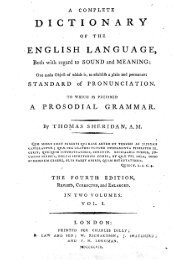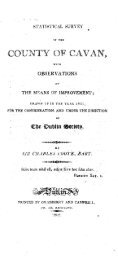I[ f@ reiffne antiquarian anb - Cavan Library Service
I[ f@ reiffne antiquarian anb - Cavan Library Service
I[ f@ reiffne antiquarian anb - Cavan Library Service
You also want an ePaper? Increase the reach of your titles
YUMPU automatically turns print PDFs into web optimized ePapers that Google loves.
and the Report of this Inquisition, which lvill be given withexplanatory notes in the succeeding pages, specified the revenuesof the several parishes with the extent and values of the termonand mensal lands. An earlier Inqz~isition held at <strong>Cavan</strong> onSeptember 19, 1590, had already issued a Report, but whichwas merely a preliminary survey giving only a list of the termonlands with their acreages and values. The information collectedby the Inquisition of 1609 is presented in greater detailand includes particulars of the lands possessed by the severalparish churches-lands which had been granted by the nativechieftains many centuries earlier for the support of the clergyand the maintenance of the churches. In the present paperI have collated the data of the 1590 Inquisition-extractedby me from the original manuscript which was preserved in thePublic Record Office, Dublin-with that of the document of 1609-which is printed among the Patent Rolls of that year-and thegeneral agreement between the two documents is manifest.It will be apparent that many of the placenames occurring inthe text are, if not actually obsolete, at least partially disguisedunder archaic or Latinised forms thereby rendering their identificationsnot immediately obvious. Evidently the Commissioners whocompiled these returns were strangers to our Gaelic orthographyand relied on phonetic renderings-a source of error in nameforms not quite unknown even in our own time. The influenceof Latin is apparent in many cases although the name forms arenot quite so obscure as those occurring in Roman documentsof an earlier period, for example in the Papal Anmtes. Errorsdue to copyists who were unacquainted with Gaelic orthographyinevitably lead to very obscure and unintelligible forms. Theidentification of the various placenames occurring in mediaevaldocuments is a work of paramount importance if the historicalvalues of these records are to be adequately realised. In elucidatingthe topography of the <strong>Cavan</strong> Inquisitions I have consulted,inter alia, the 17th century townland maps-the Jacobean PlantationMap of 1609 and the Down Survey compiled under thedirection of Sir William Petty in 1654-55. These maps are indispensablefor the exact location of the many placenames whichhave since become obsolete. It is true that in many respectsthese maps are very imperfect : in the case of the 1609 map theorientation is very defective ; but they prove very useful guidesespecially in cases where the original plqnuscripts may be partlyillegible and the orthography doubtful. The Fiants of Elizabeth'sreign furnish many 16th century forms of local and personalnames, but the orthography is generally so defective that identificationis very often a matter of considerable difficulty, andconclusions cannot be drawn with certainty from these lists.The Fiants, however, preserve many names which are now obsoleteand which may be generally located by referring to the maps





